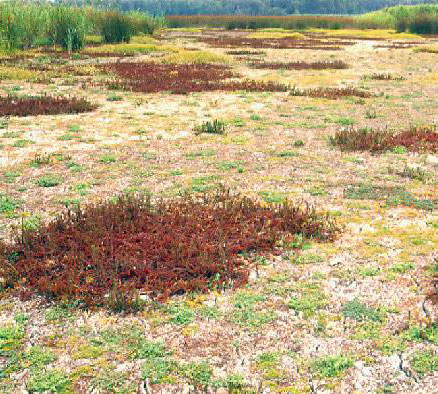Background
Refuge habitats
Drought, like other forms of ecological disturbance, can remove some of the habitat areas that biota would normally use. The biota become restricted to isolated 'refuge habitats'.
Refuge habitats take many forms and are found in many or all types of aquatic ecosystem. The types of refuges that are important will depend on both the ecosystem type and the biota that need to use them. (See Refuge identification and mapping.)
They have in common that they support particular aquatic biota, or sustain some moisture during dry spells and drought, making the effects less severe.
Waterholes, floodplain lagoons and riverine pools are commonly thought of as aquatic refuges in riverine landscapes. But there are also other refuges in both temporary and permanent streams. Examples include:
- logs,
- wet patches under-banks,
- riffles,
- streambed sediments,
- yabby holes,
- riverside and riverbed vegetation.
All of these can support freshwater species that cannot exist without water (i.e. those that have no resistance traits), or help to sustain moisture in their habitats during dry spells and drought.
In streams and rivers where normally permanent flows are being reduced or lost (for whatever reason), streams, or sections therein that continue to flow are potentially important refuges. Such areas are more likely to be found in spring-fed streams, confined valleys and, in some cases, in the larger downstream sections of the river network.
Because drought has such widespread ecological effects, the range of stream biota across a riverine network need more than just high-quality (ecologically) types of refuge habitat, such as those above. To survive they will also use less ideal niches in any critical part of the network, even parts that are in need of ecological restoration. (See Refuge identification and mapping.)
Refuge habitats in arid and semi-arid Australia
River systems of the arid interior of Australia characteristically experience long periods (up to several years) without any river flows, though the periods may be broken by some short-duration inflows ('freshes'). Occasionally there are very large floods that inundate extensive floodplains. With rainfall being uncommon in arid and semi-arid zones, droughts are difficult to detect relative to normal variability.
Arid-area rivers have large, deep waterholes that can persist in the river channel for 1-2 years without rainfall or inflow from upstream, before completely drying up. These refuges support freshwater plants and animals that depend on the presence of water. (See Dryland River Refugia articles in Watershed.)
Human effects
All types of stream refuges can be made less effective or damaged by human activities, and as a result their capacity to sustain aquatic life during droughts may be severely diminished.
However, management can alleviate some of this, either through proactive planning and action between droughts, or by reactive responses during drought.
Desirable ecological condition for refuge habitats
- Reliable refuges that will retain enough water throughout the drought.
- Water quality that is good enough to support (rather than destroy) the life of the ecosystem.
- Not subject to physical disturbance (natural, artificial, present, future).
- Access between freshwater habitat (wetland, pool, stream) and refuge, so the refugees can recolonise the main habitat when the drought breaks.
Useful references
See downloads:
- Billabongs: refuges or fish traps?
- Progress in understanding dry rivers.
- Life in the slow lane: how a freshwater turtle comes to thrive in the outback.
- Dryland River Refugia newsletters nos. 1 (2002) and 2 (2003).
Keywords:
Topics:
| Recovery from drought | View Frequently Asked Questions | View Bibliography |

